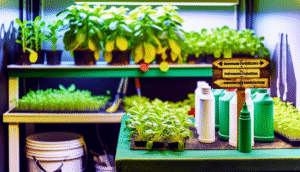Hydroponics: An Efficient Method of Growing Plants
Hydroponics is a method of growing plants without soil, utilizing nutrient-rich water solutions to deliver essential minerals directly to plant roots. This system allows for more efficient resource usage, resulting in faster growth rates, increased yields, and the potential for year-round cultivation, regardless of environmental conditions. Fundamental concepts of hydroponics include the use of various techniques such as nutrient film technique (NFT), deep water culture (DWC), and aeroponics, which all optimize nutrient delivery and oxygenation to plant roots. [Source: AGrownets]
Advantages of Hydroponics Over Traditional Agriculture
One of the main advantages of hydroponics over traditional soil-based agriculture is its ability to conserve water. Hydroponic systems can use up to 90% less water compared to conventional farming methods due to targeted irrigation practices that minimize evaporation and runoff [Source: AGrownets]. Additionally, hydroponics can be implemented in urban settings, allowing for local food production, which reduces transportation costs and the carbon footprints associated with food logistics.
Moreover, hydroponics alleviates many challenges faced in soil gardening, such as pests and soil-borne diseases, leading to healthier plants and a reduced need for chemical pesticides.
Nutrient Management in Hydroponics
Hydroponics relies on a delicate balance of nutrients and pH levels to ensure optimal plant health. The uptake of nutrients occurs through a process known as ion exchange, where plants absorb dissolved nutrients from the solution via their root systems. Essential elements, such as nitrogen, phosphorus, and potassium, must be present in specific concentrations to support various growth stages; imbalances can lead to nutrient deficiencies or toxicities, directly impacting plant health and yield [Source: ScienceDirect].
Maintaining the pH of the nutrient solution is crucial, as it influences nutrient availability. Generally, the optimal pH range for hydroponic systems is between 5.5 and 6.5. Deviations from this range can cause nutrient lockout, where plants cannot uptake specific nutrients despite their presence [Source: Gardening Know How].
Common Challenges and Troubleshooting Tips for Hydroponic Farmers
Hydroponic farmers may encounter several challenges, including nutrient deficiencies, root rot, pest infestations, and algae growth. Nutrient deficiencies can manifest as yellowing leaves or stunted growth, often due to imbalanced pH levels or insufficient nutrient concentrations [Source: AGrowNets]. To combat issues like root rot, ensure adequate oxygenation in the nutrient solution by using air pumps and maintaining proper drainage.
Pest infestations, such as aphids and spider mites, require integrated pest management techniques for effective control [Source: AGrowNets]. Algae growth can be mitigated by storing nutrient reservoirs in opaque containers and using UV sterilizers [Source: AGrowNets].

FAQ-
1. ❓ What is hydroponics and how does it work?
Hydroponics is a method of growing plants without soil, using a nutrient-rich water solution. Plants are supported in an inert medium (like cocopeat or clay pellets) and absorb nutrients directly from the water.
2. ❓ Can I really grow healthy plants in hydroponics using homemade liquid fertilizers?
Yes, you can grow healthy plants using homemade liquid fertilizers, provided they supply the essential macro and micronutrients like nitrogen, phosphorus, potassium, calcium, magnesium, and trace elements.
3. ❓ What are some common ingredients for homemade hydroponic fertilizers?
Some effective ingredients include compost tea, banana peel tea (for potassium), fish emulsion, wood ash solution, Epsom salt (for magnesium), and diluted urine (with precautions).
4. ❓ How do I prepare a basic homemade liquid fertilizer for hydroponics?
A simple recipe includes:
-
1 part compost or vermicompost
-
Soaked banana peels
-
Epsom salt
-
Water (dechlorinated)
Let the mixture sit for 24–48 hours, strain, and use it as a nutrient solution after checking pH and EC levels.
5. ❓ How often should I change the nutrient solution in hydroponics when using homemade fertilizers?
It is recommended to change the solution every 7–10 days to avoid buildup of unwanted residues and to maintain nutrient balance.
6. ❓ How do I measure the strength of my homemade fertilizer solution?
Use a TDS (Total Dissolved Solids) or EC (Electrical Conductivity) meter to check the nutrient concentration. Most leafy greens prefer 800–1200 ppm (parts per million).
7. ❓ What is the ideal pH range for hydroponic solutions?
The pH should be between 5.5 and 6.5 for most hydroponic crops. You can use pH testing kits or digital meters and adjust using lemon juice (to lower) or baking soda (to raise).
8. ❓ Are there risks involved in using homemade fertilizers in hydroponics?
Yes, if not properly prepared or filtered, homemade fertilizers can introduce pathogens, clog systems, or cause nutrient imbalances. Always strain solutions well and monitor plant health regularly.
9. ❓ Which plants are best suited for hydroponics with DIY fertilizers?
Leafy greens like spinach, lettuce, coriander, mint, basil, and herbs respond well. Tomatoes and peppers can also grow well with properly balanced DIY nutrients.
10. ❓ How can I improve the effectiveness of homemade fertilizers in hydroponics?
-
Regularly monitor pH and EC levels
-
Use aeration to keep water oxygenated
-
Add micronutrient-rich solutions like seaweed extract
-
Rotate nutrient recipes to avoid deficiencies
Conclusion
Both nutrient uptake and pH maintenance are integral to successful hydroponics, significantly impacting crop health and productivity. Regular checks and adjustments to the nutrient solution create a thriving environment for plants, maximizing growth potential. For more information on hydroponic practices, explore our detailed guide on hydroponic farming.
Sources
- AGrowNets – Hydroponic Farming
- AGrowNets – Benefits of Hydroponics
- AGrowNets – Common Hydroponic Problems
- AGrowNets – Best Practices for Hydroponics
- AGrowNets – Pest Management in Hydroponics
- AGrowNets – Water Quality in Hydroponics
- ScienceDirect – Nutrient Management
- Gardening Know How – Successful Hydroponics Nutrient pH
- Maximum Yield – Nutrient Management in Hydroponics